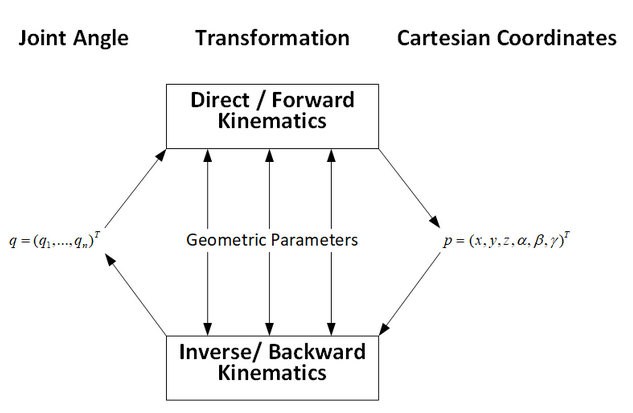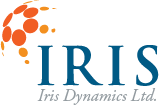- April 12, 2023
Forward and Inverse Kinematics: Explained
What is Forward Kinematics?
Forward Kinematics is the calculation of the position and orientation of an end effector using the variables of the joints and linkages connecting to the end effector. Given the current positions, angles, and orientation of the joints and linkages, forward kinematics can be used to calculate the position and orientation of the end effector.
While accurate position and orientation of the end effector is important, it is reliant on comprehensively understanding the variables of the joints and linkages connected to the end effector, as well as having a solvable model.
What is Inverse Kinematics?
Inverse Kinematics is the calculation of the variables of the set of joints and linkages connected to an end effector. Given the position and orientation of the end effector, inverse kinematics can be used to calculate the variables regarding those joints and linkages including position, angle, and orientation.
The appropriate path to move from one position to another can be calculated using a Jacobian matrix.

Using these two calculations circularly, one can both move and track movement. Using the variables of the joints to calculate where the end effector is, then setting the desired position and orientation of the end effector, then calculating the required joints and linkages variables needed to achieve such a position and orientation, then calculating the movement path to arrive at the desired variables of all the joints and linkages which in turn has moved the end effector to the desired location and orientation. The process can be repeated for any new end effector position and orientation desired.
 However, because this is a set of circular functions feeding back into each other, errors compound and eventually result in the system being entirely disconnected from the reality of the situation.
However, because this is a set of circular functions feeding back into each other, errors compound and eventually result in the system being entirely disconnected from the reality of the situation.
This is typically solved by checking with sensors for accuracy or entirely substituting sensor readings in for certain variables.
Remember, the whole cycle is based on an understanding of either the variables of the joints and linkages, or the variables of the end effector and using one to calculate the other.
Traditionally, things like position sensors, encoders, or spatial tracking objects and equipment are used.
FKM and IKM Calculations
Why are Forward and Inverse Kinematics Important?
Inverse Kinematics enables movement of Stewart Platforms according to its Degrees of Freedom (DoFs). For example, if the desired motion is to sway side to side but otherwise remain level, an Inverse Kinematic Model is used to calculate the length of each of the actuators throughout the motion. The inverse kinematics translate the motions a simulator cares about like “Surge, Sway, Heave, Roll, Pitch, and Yaw” into the position commands for the actuators.
Forward Kinematics calculates the position of the platform’s top plate. In other words, it measures the actual Surge, Sway, Heave, Roll, Pitch, and Yaw. It finds this using the measured length of the actuators.
The importance of Inverse Kinematics is obvious: in order to move the platform to a certain position, Inverse Kinematics is used to reveal how to position the actuators to achieve that. Forward Kinematics is useful in more subtle cases and is particularly valuable for Virtual Reality applications as seen below.
The Raven-6DoF Features Ultra Low Latency FKM and IKM Calculations
When a person experiences Virtual Reality they are allowed to move around in a simulated environment. They can stick their head out of a window to see the hanging load underneath a helicopter or swivel their head around to look around. This works because the VR Headset detects motion and reports to the simulated environment how the user is moving around, so the simulation can render the resulting visuals to the user.
The use of Stewart Platforms enhances the Virtual Reality experience, and can help combat VR motion sickness. The motion cues given from a platform relieve the disconnect that riders feel when the eye experiences motion but the inner ear doesn’t. When this occurs, our brains believe they’ve been poisoned resulting in nausea. Using real motion, the inner ear experiences the same reality presented to the eye. The Stewart Platform, therefore, moves a rider around to satisfy their inner ear. A problem arises, however, because the VR Headset can’t discern which motions it experiences are due to the rider moving their head or the motions of the platform itself.
To illustrate, consider two situations: a VR rider in a helicopter first corrects their posture by sitting up straighter, and then that same VR rider lifts off in their virtual helicopter. When the rider corrects their posture, the VR headset measures the upward motion, and the rider experiences moving up in the cockpit, they see a bit more over the dash. Next, the pilot lifts off, and the Stewart Platform starts to rise. Again, the VR headset measures upward motion, but this time the pilot experiencing upward motion in the cockpit is undesired. It would be very confusing for the pilot if their head lifted up through the roof of the cockpit every time they lifted off, or shot out the side of their car when they went around a corner. Stewart Platforms motions must therefore be cancelled from the motion measured by the VR headset leaving only the rider’s motions to be rendered.
Forward Kinematics are critical to accomplishing this task. The actuator positions, which are typically measured very accurately, are used to quickly calculate platform motion, which can then be deleted from the measured headset motion. Sometimes external sensors like accelerometers are placed on a platform and used to aid in motion deletion. A Forward Kinematic model not only replaces these sensors, but when done correctly can also do it with improved latency, vibration resistance, and consistency.
Iris Dynamics’ Raven-6DoF Motion Platform Development Kit features FPGA powered FKM and IKM calculations which offer industry leading latency making it ideal for VR applications. The Raven-6DoF Kit can be used to built motion platforms with 6 degrees of freedom in geometries to suit any application. Learn more about Raven-6DoF here.
